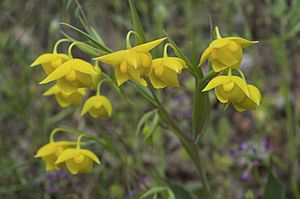Calochortus amabilis facts for kids
Quick facts for kids Calochortus amabilis |
|
|---|---|
 |
|
| Scientific classification | |
| Genus: |
Calochortus
|
| Species: |
amabilis
|
The Calochortus amabilis is a beautiful wild flower from the Calochortus family, also known as the lily family (Liliaceae). People call it by many fun names like Diogenes' lantern, yellow globe-tulip, golden fairy lantern, or Chinese lantern. It's a special plant because it's only found in one part of the world!
Contents
Where Does It Grow?
This lovely plant is found only in northern California. You can spot it in places like Mount Diablo State Park and areas north of the San Francisco Bay Area. It grows in the Northern California Coast Ranges and Klamath Mountains. You'll find it at different heights, from about 330 feet to 4,900 feet above sea level.
It likes to grow on dry hillsides in California oak woodlands and chaparral areas. The soil can be very rocky or even yellow clay. This plant enjoys a lot of rain in winter, usually about 30 inches or more each year. After the wet winter, it has a hot, dry summer. Winters are cool but not super cold.
The Calochortus amabilis grows from mid-winter until it flowers and makes seeds in April, May, or June. Then, it takes a long nap (becomes dormant) from mid-June until November.
What Does It Look Like?
The Calochortus amabilis is a perennial herb, which means it's a plant that comes back year after year and doesn't have a woody stem. It grows from a bulb, like an onion. Its stem stands upright and can be anywhere from 4 to 20 inches tall. The stem is a bit waxy and often branches out.
At the bottom of the stem, there's a long, flat, waxy leaf that can grow up to 20 inches long. This leaf stays green even when the plant is flowering.
The plant produces two or more flowers that hang downwards, like little bells. Each flower has yellow sepals that spread out and yellow petals that often have brown speckles. The inside of the petals feels waxy and is covered in tiny hairs. After the flowers, the plant makes a winged seed pod (called a capsule) that can be up to 1.2 inches long. This pod holds dark brown seeds.
- Height: It grows to about 4 to 20 inches tall.
- Stems: The stems are strong, waxy, and often branch out.
- Leaves: There are two kinds of leaves. The main leaf at the bottom is long and shiny, staying green through flowering. Smaller leaves grow higher up on the stem.
- Flowers: The flowers hang down in groups. They are about 1 to 1.5 inches long and bloom from April to June. The flower is shaped like a sphere, with petals that might slightly overlap at the top.
- Sepals: These are three noticeable, spreading parts, often tinged green or red.
- Petals: There are three yellow petals, sometimes with green hints or brown spots on the outside. They are slightly longer than the sepals and have tiny hairs along their edges.
- Fruit: The seed pod hangs down and is shaped like an oblong with wings. It's about 0.8 to 1.2 inches long.
- Seeds: The seeds are dark brown and have irregular shapes.
How Do People Use It?
Food
The bulbs of the Calochortus amabilis have been a traditional food for the Kashaya Pomo people in California. They would bake or boil the bulbs and eat them, much like we eat potatoes today. The Pomo people really loved this food and called it "bo."
Growing It in Gardens
Calochortus amabilis is also grown as an ornamental plant in gardens. This means people grow it because it's pretty! Special plant nurseries that focus on native plants sell it for gardens that want to look natural or attract wildlife.
- Hardiness: It's a tough plant, especially if you cover the soil around it with mulch. In very cold places, it can be grown in a special greenhouse that isn't heated.
- Light: It likes sunny spots but can also grow in partial or full shade.
- Soil: This plant can grow in different types of soil, but it prefers soil that drains water well. It likes soil that has a lot of organic matter (like compost) mixed with sand or gravel.
- Water: It can handle dry conditions, but it needs water during its growing season. If you grow it in pots, it needs regular watering. During its dormant season (when it's sleeping), the soil needs to be completely dry. Some gardeners even dig up the bulbs for the summer to make sure they stay dry and don't rot.
- Growing from Seed: You can plant the seeds as soon as they are ready. They don't need any special treatment to sprout.
- Pests and Diseases: This plant usually doesn't have problems with pests or diseases.
What Does Its Name Mean?
The name Amabilis means 'pleasing', 'likeable', or 'lovely'. The word Calochortus comes from Greek words that mean 'beautiful grass'. This is because the plant has grass-like leaves. So, the full name Calochortus amabilis literally means 'lovable, beautiful grass'.
See also
 In Spanish: Calochortus amabilis para niños
In Spanish: Calochortus amabilis para niños

